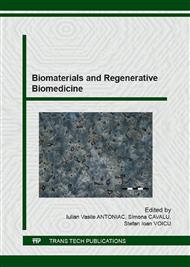[1]
Popescu I., Antonescu D., Surgery Handbook, vol. X; Traumatology and orthopaedics, Publisher Editura Academiei, Bucharest (2009).
Google Scholar
[2]
Purghel F., Badea R., Antoniac I., Medical notions for engineers, Publisher Printech, Bucharest (2011).
Google Scholar
[3]
Miculescu F., Bojin D, Ciocan L.T., Antoniac I., Miculescu M, Miculescu N, Experimental researches on biomaterial-tissue interface interactions, JOAM, 9: 11 (2007), 3303 – 3306.
DOI: 10.4028/www.scientific.net/kem.638.14
Google Scholar
[4]
Ionescu R, Mardare M, Dorobantu A, Vermesan S, Marinescu E, Saban R, Antoniac I, Ciocan D.N., Ceausu M., Correlation between materials, design and clinical issues in the case of associated use of different stainless steels as implant materials, KEM, 583 (2014).
DOI: 10.4028/www.scientific.net/kem.583.41
Google Scholar
[5]
Niculescu M, Laptoiu D, Miculescu F, Antoniac I, Biomaterials view on the complications associated with hip resurfacing arthroplasty, Advanced Materials Research, 1114 (2015), 247-252.
DOI: 10.4028/www.scientific.net/amr.1114.247
Google Scholar
[6]
Botez P, Sirbu P, Simion L, Munteanu F, Antoniac I, Application of a biphasic macroporous synthetic bone substitutes CERAFORM®: clinical and histological results, EJOST, 19: 6 (2009), 387– 395.
DOI: 10.1007/s00590-009-0445-7
Google Scholar
[7]
Niculescu M, Laptoiu D, Miculescu F, Antoniac I, Metal allergy and other adverse reactions in patients with total hip replacement, Advanced Materials Research, 1114 (2015), 283-287.
DOI: 10.4028/www.scientific.net/amr.1114.283
Google Scholar
[8]
Bunea D; Antoniac V; Trante O; Trante D; Trante C; Studies and research on the austenitic stainless seels casting and/or forging in order to provide the conditions for using like biomaterials, Materials for Medical Engineering, Publisher Wiley-VCH (2000).
DOI: 10.1002/3527606149.ch11
Google Scholar
[9]
Park J.B., Bronzino J.D., Biomaterials: Principles and Applications, Publisher CRC Press, (2003), 1-22.
Google Scholar
[10]
Ghiban B., Metallic Biomaterials, Publisher Printech, Bucharest (1999), 1-40.
Google Scholar
[11]
Ghiban B., Mechanical and corrosion behaviour of some devices for ostheosinthesis, Advanced Materials Research, 23 (2007), 257-260.
DOI: 10.4028/www.scientific.net/amr.23.257
Google Scholar
[12]
Razvan I, Iulian A, Cosmin C, Florin M, Eugeniu V, Munteanu C, Moldan D, Marius N, Potential solutions to increase the corrosion resistance of metallic surgical instruments using different types of ceramic coatings, KEM, 614 (2014), 206-211.
DOI: 10.4028/www.scientific.net/kem.614.206
Google Scholar
[13]
Mihaela M.A., Brandusa G., Nicolae G., Iulian A., Corrosion behaviour in Ringer solution of Ti-Mo alloys used for orthopaedic biomedical applications, Solid State Phenomena, 188 (2012), 98-101.
DOI: 10.4028/www.scientific.net/ssp.188.98
Google Scholar
[14]
Togan V; Ionita G; Antoniac I; Corrosion Behavior of Ti6Al4V Coated with SiOx by PECVD Technology, KEM, 583 (2014), 22-27.
DOI: 10.4028/www.scientific.net/kem.583.22
Google Scholar
[15]
Atasiei T; Antoniac I; Laptoiu D; Failure causes in hip resurfacing arthroplasty - retrieval analysis, International Journal of Nano and Biomaterials, 3: 4 (2011), 367-381.
DOI: 10.1504/ijnbm.2011.045882
Google Scholar
[16]
Antoniac I; Laptoiu D; Miculescu F; Istrate R; Trisca-Rusu C; Microscopy analysis of total knee prosthesis failure caused by polyethylene wear, European Cells and Materials, 16: S1 (2008), 54.
Google Scholar
[17]
Cristescu I; Antoniac I; Vilcioiu D; Safta F; Analysis of centromedullary nailing with implant failure, KEM, 638 (2015), 130-134.
DOI: 10.4028/www.scientific.net/kem.638.130
Google Scholar
[18]
Ionescu R; Cristescu I; Dinu M; Saban R; Antoniac I; Vilcioiu D; Clinical, biomechanical and biomaterials approach in the case of fracture repair using different systems type plate-screw, KEM, 583 (2014), 150-154.
DOI: 10.4028/www.scientific.net/kem.583.150
Google Scholar
[19]
Bane M; Miculescu F; Blajan AI; Dinu M; Antoniac I; Failure analysis of some retrieved orthopedic implants based on materials characterization, Solid State Phenomena, 188 (2012), 114-117.
DOI: 10.4028/www.scientific.net/ssp.188.114
Google Scholar
[20]
Wall E.J., Jain V., Vora V., Mehlman C.T., Crawford A.H., Complications of titanium and stainless steel elastic nail fixation of pediatric femoral fractures, J Bone Joint Surg. Am, 90: 6 (2008), 1305 -1313.
DOI: 10.2106/jbjs.g.00328
Google Scholar
[21]
Teoh S.H., Fatigue of biomaterials: a review, International Journal of Fatigue, 22: 10 (2000), 825–837.
DOI: 10.1016/s0142-1123(00)00052-9
Google Scholar
[22]
Collings E.G., Boyer R., Welsch G., Materials properties handbook. Titanium alloys, ASM International (1994), 483-609.
Google Scholar


